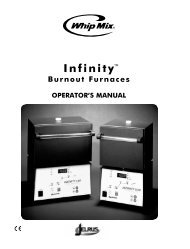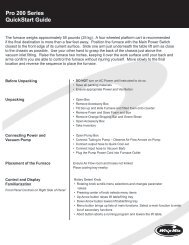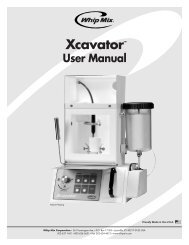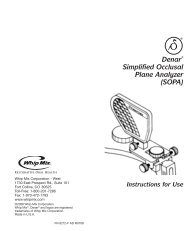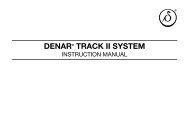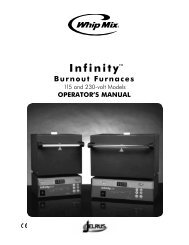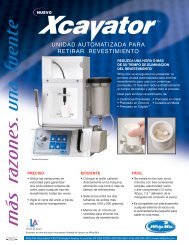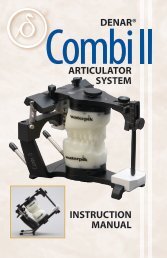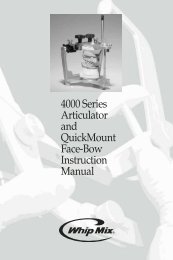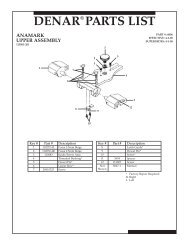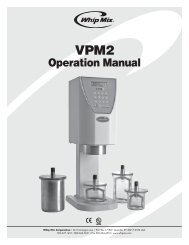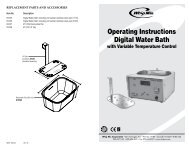ProCal Manual - Whip Mix
ProCal Manual - Whip Mix
ProCal Manual - Whip Mix
- No tags were found...
Create successful ePaper yourself
Turn your PDF publications into a flip-book with our unique Google optimized e-Paper software.
<strong>ProCal</strong> Operating InstructionsProduct OverviewThe Pro Cal Calibration Kit is a professional gradeinstrumentation system designed to rapidly monitor thecalibration status of your furnace, and automaticallyrecalibrate the furnace to factory specifications.It is recommended that you read this manual thoroughlybefore using the kit as there are valuable examples ofprocedures and decisions you will want to be acquaintedwith in order to maximize the benefits you’ve invested in.What You Can Do With ItQC = Quick Check (Pro 200 Series & Pro 100 Series withAdaptor #96026, Sold SeparatelyThe Quick Check feature allows you to rapidly spot checkthe need for calibration. Simply place the Special FiringTray on the Lift Table, connect the Tray to the InstrumentBox and the Instrument Box to the furnace calibrationport, and dial in the desired temperature you want toverify. The LCD readout on the <strong>ProCal</strong> box should agreewith the furnace display to within three degrees Celsius. Ifnot, you can choose one of several options:1. If you check several temperatures and only oneseems to be different, you can go into the firingprograms which have hold temperatures at thatvalue and use the Program Level Fusing Adjust tofine tune just those programs.2. If you check several temperatures and they all eitheroverfire or underfire, you can go into the SpecialFunctions menu and select High Fusing Adjust fortemperatures over 800°C or Low Fusing Adjust fortemperatures under 800°C and enter the averagecorrection value needed.3. You can do a fully automated calibration.Full Recalibration (Pro 200 Series Only)The full recalibration mode requires several hours tocomplete, so you’ll want to reserve it for times when thetemperature is more than three degrees from nominal.Why does it take so long? To get a valid calibrationwhich will most closely match the conditions in which itis used every day the furnace must be fully heat soaked.Secondly, the automatic calibration program requiresone pass at three separate temperatures to build thecalibration file. Thirdly, a second complete pass isnecessary to confirm that the calibration pass is valid.This is exactly the same rigorous process that yourfurnace went through before it left the factory originally.Why Do Furnaces Require PeriodicTemperature Recalibration?There are several reasons why furnaces require periodicQC checking and recalibration:Effluents given off by the materials fired in the furnacecan deposit on the platinum/palladium thermocouple andin some cases, chemically react with the noble metals,thereby affecting the temperature sensed.Oxide layers can build up on the thermocouplethrough many cycles of vacuum, then exposure toair and chemically react with the noble metals in thethermocouple.Prolonged high heat exposure can eventually crystallizethe noble metals making them brittle and inhibiting thebuildup of charge on each leg. The millivolts given off bya thermocouple to register temperature accumulate allalong the heat exposed legs of the thermocouple, not justat the tip.The heater wire also becomes brittle and scaly along itssurface after extended usage. This can affect the infraredspectrum irradiated by the heater and redirect the anglewhich the photons emitted by the heater such that theones striking the thermocouple are more diffused andtherefore create less charge buildup in the thermocouple,affecting the calibration.How It Works -What’s it doing in there?The thermocouple in the Special Firing Tray monitors thefurnace activity and reports its accumulated charge back tothe Instrument Box. The Instrument Box filters the electricalnoise inherent with very low level signals in the microvolt tomillivolt range. The cleaned-up signal is then sent to a preamplifierwith a built in digital filter to further boost the signaland clean it up some more. Finally, the signal is presentedto a 24 bit Analog to Digital Converter (ADC) for conversioninto digital ones and zeros to be transmitted to the furnacecomputer. There is also a local “ambient” temperaturesensor inside the Instrument Box which monitors the “coldjunction” temperature at the point where the thermocouplealloys transition into the electronics. This cold junctiontemperature sensor output is automatically used by thecomputer inside the Instrument Box to correct anymeasurement errors as the reference signal from theSpecial Firing Tray makes its way back to the furnace.Once the digital reference value from the Special FiringTray is received back in the furnace computer its value iscompared to the internal furnace thermocouple and thesign (relative over-firing or under-firing) and the magnitudeof the difference are stored permanently in the furnacecomputer.After the calibration process is complete, every timethe furnace temperature is commanded to a specifictemperature, the furnace computer looks at the targettemperature, determines which calibration value isappropriate for that target value, and either adds orsubtracts the stored calibration correction value in order toproduce the accurate temperature desired, all in real-time.1



